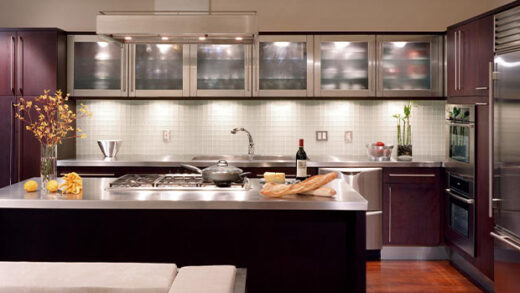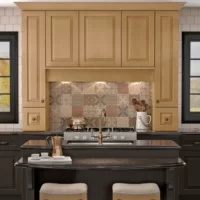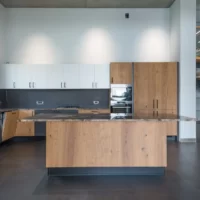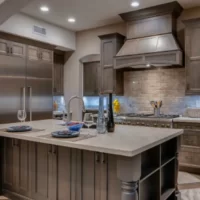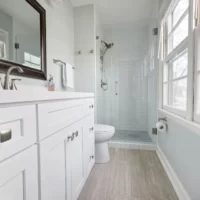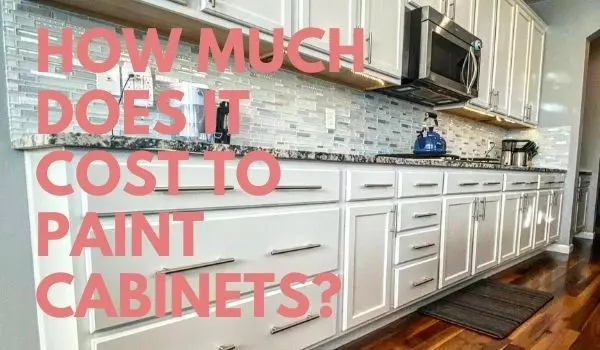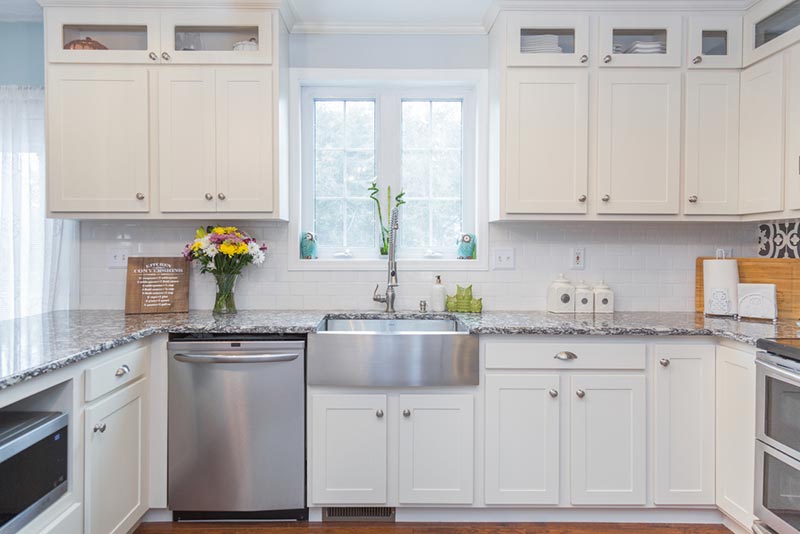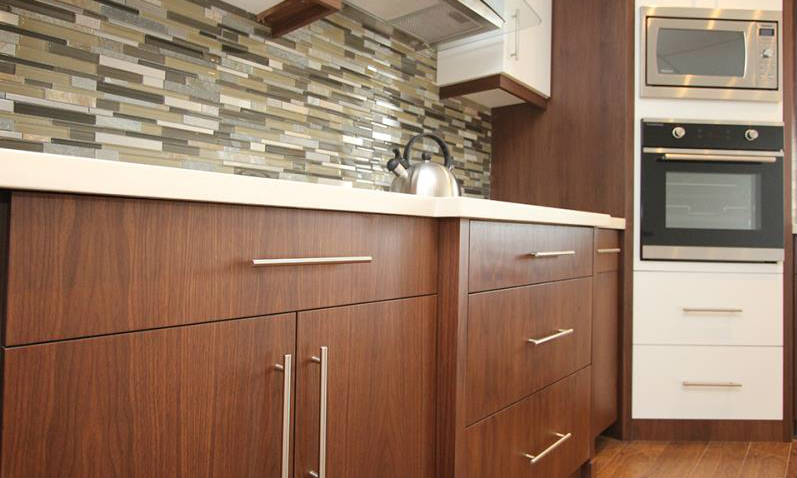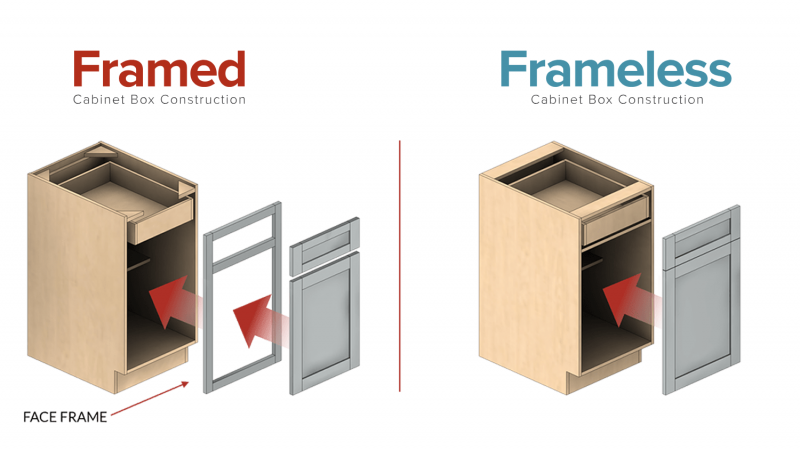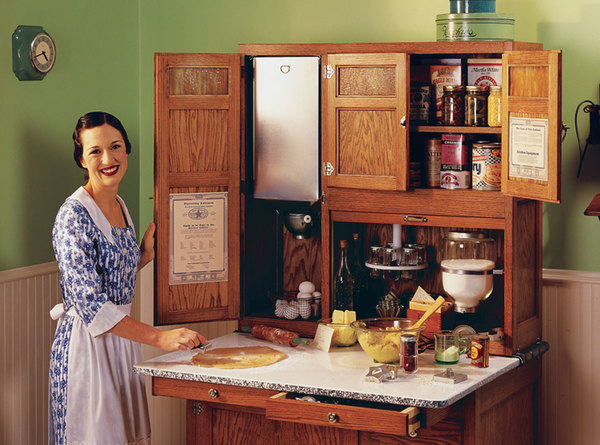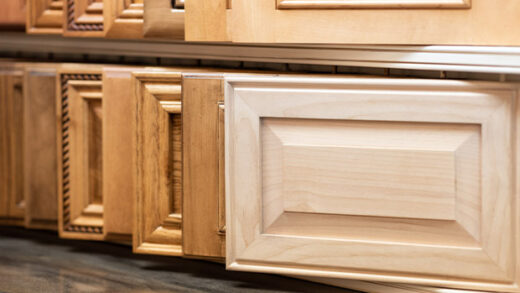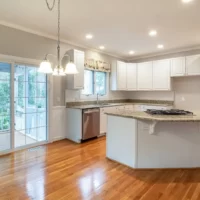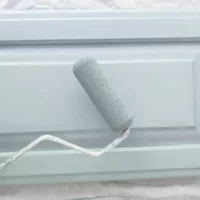The vast majority of high-quality paint finishes begin with a good all-purpose primer because it aids in paint adhesion to the surface.
Everyone has a preference for the best primer for their kitchen cabinets. For your convenience, we’ve listed the top-rated primers for kitchen cabinets that provide improved adhesion and durable protection.
You may also like: Best Paint Brush For Cabinets
Table of Contents
Best Primer List For Kitchen Cabinets
- 1. KILZ Adhesion Primer, Interior/Exterior: Best Overall
- 2. KILZ Restoration Interior Primer: Best Blocker
- 3. INSL-X SXA11009A-04 Stix Acrylic Waterborne Bonding: Best Bonding
- 4. Rust-Oleum 271009 Advanced Synthetic Shellac Primer: Best For Spraying
- 5. Zinsser Bulls-Eye 1-2-3 Acrylic Primer and Sealer: Best Bang For The Buck
- 6. Zinsser 03504 Cover Stain Oil Primer Sealer: Best For Small Projects
Best Primer For Kitchen Cabinets Review
1. KILZ Adhesion Primer, Interior/Exterior: Best Overall
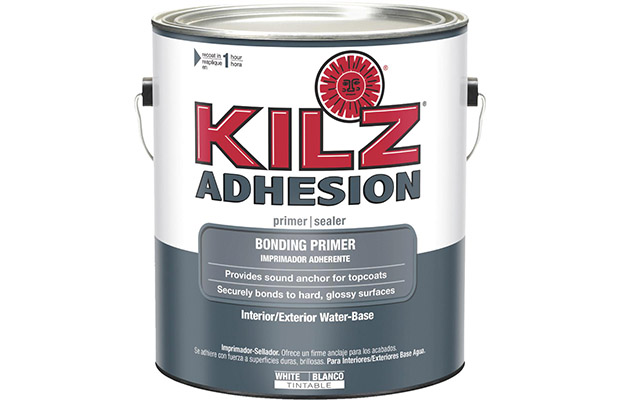
The environmentally friendly, water-based Kilz Adhesion High-Bonding primer boasts simple application, good coverage, and exceptional adhesion. Without first sanding new wood, composites, or glossy surfaces, the white primer can be applied. It takes 30 minutes for it to feel dry to the touch and an hour to recoat.
Its ability to be used with almost any top coat, such as epoxy, solvent-based lacquers, and latex, is one of its main advantages. It does a decent job of blocking odors and stains, but not as well as some other products. 300 square feet will be covered by a 1-gallon can.
Pros
- Reputable brand
- Affordable for the size
- Suitable for most surfaces
- Applied with a brush, roller, or spray
Cons
- Not stain or odor blocking
2. KILZ Restoration Interior Primer: Best Blocker
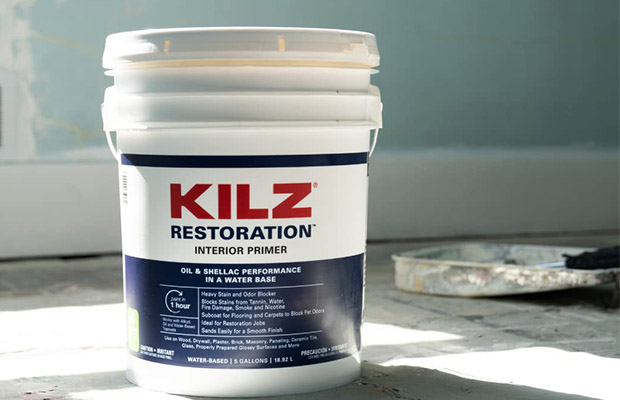
Primers made of oil or shellac are typically used by people who need strong stain- and odor-blocking capabilities for kitchen cabinet painting projects. An alternative that is low in volatile organic compounds is Kilz Restoration. Its unique water-based formula can hide tannins, nicotine, and fire damage, making it a great option for old and heavily soiled kitchen cabinets. Despite being white, it is good at concealing dark hues and heavily knotted wood.
To ensure a high-quality finish, cleaning and/or sanding are necessary; however, fast-drying Kilz Restoration can be reapplied or top coated in just one hour. It offers excellent coverage at 300–400 square feet per gallon and is compatible with the majority of latex and oil-based finishes. On top of pre-existing finishes, it can also be applied to drywall, masonry, tile, and a variety of other surfaces.
Pros
- Environmentally friendly formula
- Great for old cabinets
- Can hide dark colors
Cons
- Quite pricey
3. INSL-X SXA11009A-04 Stix Acrylic Waterborne Bonding: Best Bonding
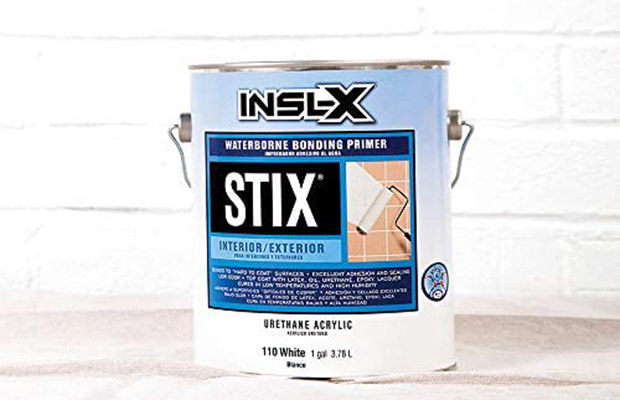
An acrylic urethane hybrid primer called INSL-X Stix combines the exceptional durability of products with an oil base with the environmental friendliness of a low-VOC, water-based formula that is simple to clean. Additionally, it has exceptional bonding properties, which allow it to adhere to virtually any surface, including Formica and other plasticized kitchen cabinets.
A white primer called INSL-X Stix can be finished with latex, oil-based products, lacquers, and epoxies. Although drying takes three to four hours, it can be used in high-humidity environments and at temperatures as low as 35 degrees Fahrenheit. However, the coverage, which is about 75 square feet per gallon, is affected by its enormous versatility.
Pros
- Bonds to almost any surface
- Low VOC formula
- Suitable for humid environments
Cons
- Long drying time
- Low coverage per gallon
4. Rust-Oleum 271009 Advanced Synthetic Shellac Primer: Best For Spraying
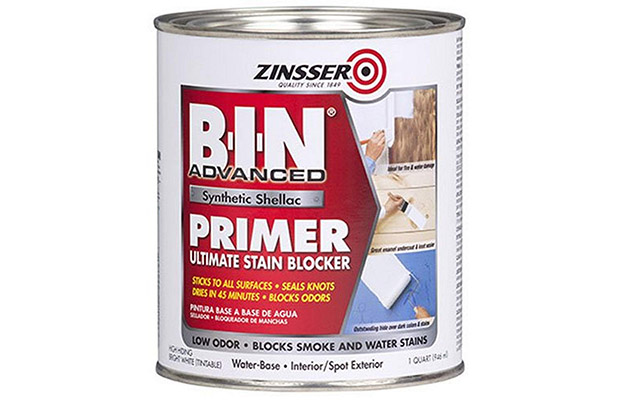
Due to its highly effective stain blocking, the Zinsser B-I-N primer (a Rust-Oleum product) is a superb option for older kitchen cabinets. Additionally, it has strong adhesion and good odor-blocking capabilities. It applies smoothly and easily, making it a particularly good choice for spray application, and leaves an incredibly smooth finish.
Although this synthetic shellac has a low VOC, it does contain alcohol, so proper ventilation is crucial. In 45 minutes, Zinsser B-I-N is dry enough to apply additional coats, making it a relatively quick-drying product. It requires denatured alcohol rather than solvents during the cleanup, which is a little more difficult than with water-based primers but not as difficult as with oil-based products.
Pros
- Fast drying time
- Excellent stain and odor blocking
- Provides a smooth finish
Cons
- Cleanup is more difficult
5. Zinsser Bulls-Eye 1-2-3 Acrylic Primer And Sealer: Best Bang For The Buck
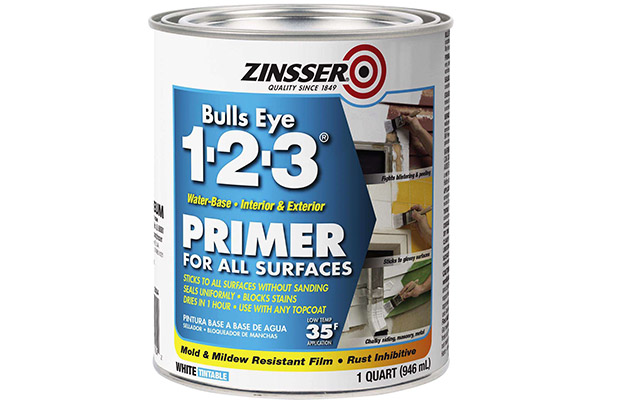
This water-based latex primer, which is reasonably priced and adaptable, can be applied to almost any surface, including plaster, concrete, metal, and a variety of kitchen cabinet materials. Zinsser 1-2-3, a gray product from Rust-Oleum, is both interior and exterior and does a good job of concealing previous finishes. The primer will accept both water- and oil-based top coats and the quick-drying formula enables recoating in just one hour.
It can sufficiently resist odors and stains. While the 100 square feet of coverage provided by the 1-gallon size is less than some rival products, it would be difficult to find a better all-arounder for the money.
Pros
- Affordable
- Blocks odors and stains
- Resists mold and mildew
Cons
- Less coverage per gallon
6. Zinsser 03504 Cover Stain Oil Primer Sealer: Best For Small Projects
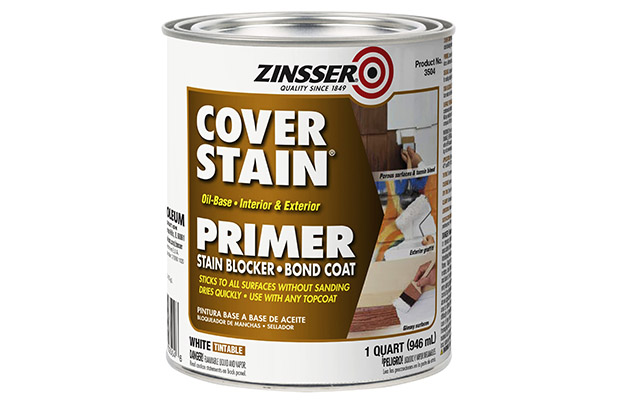
Due to its ability to add additional shine and ease of sanding, Zinsser 03504 Cover Stain lowers labor costs.
In addition, this product not only conceals the dark color and blocks most stains, but it also stops water, smoke, and nicotine stains from penetrating the coat.
It is perfect for small projects like renovations, new construction, and priming.
Pros
- Adds shine.
- It’s affordable.
- easy to use (great for beginners).
- Not mold-resistant.
Cons
- The coat dries in about one hour, which is slow
Should Cabinets Be Primed?
Always prime stained kitchen cabinets before painting, ideally with two coats. Unless they have already been primed, even painted cabinets should be primed. Additionally, the paint should be in good condition with no visible tannin bleed.
When you use the proper primer, it should seal the surface of cabinets and really well bond with wood and paint to prevent rub-off when cleaning. Without using primer, painting directly over stained cabinets will cause tannin and the existing stain to bleed through the paint, producing an appalling paint job no matter how many coats you apply.
How To Chose The Best Primers For Kitchen Cabinets?
The most well-known brands on the market were examined when creating our list of suggestions in order to determine their advantages and disadvantages in various categories. Our top picks give customers a choice based on their unique requirements, such as good adhesion properties, low VOC formulation, or impressive odor and stain-blocking abilities—a highly sought-after quality when looking at primers for kitchen cabinets.
All of the products we suggest have good coverage and can be used on various surface types. With small quart-size cans for smaller do-it-yourself projects and large gallon cans for more demanding renovation work, we also made sure to offer a selection to suit a variety of budgets.
Different Types Of Primers
There are three different kinds of primers, and each one has unique uses and advantages. Let’s elaborate:
Oil-based Primer
Because they are more likely to select satin or glossy paints when painting a cabinet, most experienced painters frequently use an oil-based primer.
Because of its exceptional bonding abilities, this kind of primer keeps stains from penetrating the topcoat.
They function well on various cabinet surfaces, including wood, metal, and previously painted surfaces.
On the other hand, they take forever to cure – especially when you add the recommended two coats.
The high VOC fumes are another negative. They produce potent odors that can harm the liver and lungs. So make an effort to wear a face mask and work in a ventilated space.
Latex Primers
We strongly advise choosing latex because they are inexpensive and simple to use if you are a novice or amateur painter. It can be applied using a variety of rollers, paintbrushes, and sprayers.
Professionals might prefer oil-based primer to latex, but latex can finish the job more quickly.
It’s a go-to choice for serious do-it-yourself homeowners and frugal weekend warriors who want to finish the job right away so they have time for other necessities.
You can complete the priming and painting tasks with latex in a single day as they dry faster than oil-based paints, which typically take three to four days to completely dry.
In conclusion, they have a strong bond and protection but are not as strong as oil-based.
Shellac Primer
Shellac primers are the unsung heroes that provide an exceptional barrier that prevents all stains from penetrating while sealing both wooden and metallic cabinets.
Consider using shellac primers if you’re sick of your surface being covered in paw prints and crayon smudges. They dry more quickly, are stain-resistant, and smell of smoking.
When using latex, oil-based, epoxy, and lacquer coatings, shellac primers are appropriate for use on wood, plaster, metal, as well as plaster.
The opposite is true—applying Shellacs is difficult. After finishing the project, thoroughly wash the tools before thinning the paint with denatured alcohol.
Factors To Consider When Choosing The Best Primer For Kitchen Cabinets
Your decision regarding the best primer for kitchen cabinets will depend on a number of factors. The type of cabinet, as well as its state and current finish, are important factors. Continue reading for more information about priming kitchen cabinets, including some technical and practical considerations, as well as solutions to the majority of problems.
Odor And Stain Blocking
Primer is either white or gray, with the exception of primers based on shellac, which can be translucent. Gray is typically used to add richness to darker colors, while white is typically chosen when a light-colored top coat will be used. When selecting a primer, it’s crucial to take into account any odors or stains that already exist on the kitchen cabinets.
Even a clean kitchen can occasionally be filled with potent odors and smoke, which can seep into the cabinets. Additionally, grease, nicotine, and food spills can leave stains on kitchen cabinets. Tannin, a naturally occurring stain that oak produces, can bleed through finishes, making it a popular material for kitchen cabinets.
Kitchen cabinet primers are increasingly popular and feature odor- and stain-blocking capabilities as a solution to these issues. For dark cabinets, a stain-blocking primer is also a wise choice when a lighter finish is desired because it will help prevent show-through and cut down on the number of coats needed.
While historically oil-based odor- and stain-blocking primers worked better, some shellac- and water-based variants can now perform the same function. However, not all primers provide all advantages, so it’s crucial to carefully examine the features of each product.
Surface And Adhesion
Creating an adhesion layer between the surface and the top coat is the primary function of primers. In essence, the primer must adhere well to the cabinet material and be able to accept the necessary finish that is painted over it.
Here’s how primers stack up for a variety of common cabinet surfaces and situations:
- On unfinished wood and engineered composites like MDF, any primer will work well.
- While several coats of a water-based primer can function just as well and likely dry just as quickly, oil-based primers typically fill wood grain the best.
- Formica and other laminates are designed to be nonstick, but existing gloss finishes can also cause adhesion issues. While these can be sanded, users can avoid the extra work by using primers either specifically described as made to stick to these surfaces or termed “high bonding” for their ability to adhere to multiple surfaces, including ultrasmooth porcelain, glass, and PVC.
Environment And Health Impacts
Some primers contain VOC, which jeopardizes the health of everyone in your household as well as your own. More annoyingly, the majority of sellers enjoy creating false expectations that their goods are environmentally friendly.
Therefore, ensure the product is labeled “low VOC or no VOC,” and then read what other customers are saying about the volatility.
Our Verdict
Customers looking for a primer that adheres well and provides good coverage on most cabinet surfaces should think about the KILZ Adhesion Primer. The Zinsser Bulls-Eye 1-2-3 has excellent stain and odor blocking dries quickly and is a little more affordable if you’re looking for something.
FAQs
Will My Kitchen Cabinets Benefit From Primer?
Painting wood cabinets is recommended, but you can paint any surface that can be scratched with sandpaper. Laminate cabinets require a special bonding primer. Your cabinets will shine with a gloss finish, but many flaws or dings could be visible. Kitchens frequently feature semi-gloss or satin finishes.
How Long Should I Let Primer Dry On Cabinets?
The recommended range is typically between one and four hours, but it’s always important to read the manufacturer’s instructions. High humidity can prevent items from drying quickly, so if you’re unsure of the drying time, give it a little more time.
Should Kitchen Cabinets Be Rolled Or Sprayed?
You can achieve your desired outcome using either of the two methods. However, a paint sprayer gives you a special opportunity to paint the cabinets quickly and get the best finish. You won’t experience dips or streaks issues, unlike when using a roller or paintbrush.
If you are accustomed to the conventional methods, however, using a paint roller and a paintbrush will still allow you to complete the project to the best of your ability.
How Many Coats Of Primer Do I Need To Paint Cabinets?
You need to apply two coats of primer on wood cabinets unless a primer container explicitly claims to get the job done in one coating. Unfinished wood needs a thick coating to prevent absorption because it is not paint-friendly.



